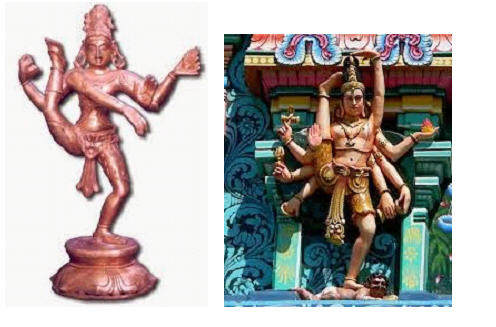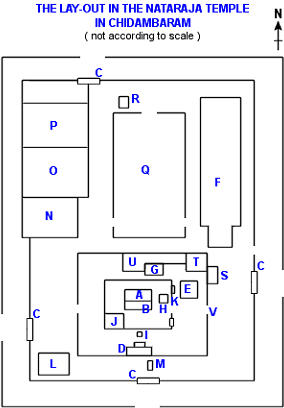Throughout all of eternity Lord Vishnu rests on Shesha, the Cosmic Snake, in Vaikuntha. Once his weight suddenly seemed to have greatly increased. Shesha asked Vishnu “why are you so much heavier, Lord?” The Lord answered “I have had a vision of Shiva doing his Cosmic Dance. I have expanded with happiness at the sight.” Shesha requested Vishnu to tell him all about Shiva’s Dance. And Lord told him everything as follows.

In the forest called Daruvanna live a community of Rishis or Seers in a hermitage. Through the performance of rituals they had achieved great knowledge and power, but they had not realized the importance of Divine Grace. Lord Shiva requested Lord Vishnu to accompany him to enlighten the Rishis, by showing them human power and knowledge were helpless without intervnetion of Divine Grace. To accomplish this purpose the two deities applied their power of Maya or Illusion. Shiva entered the hermitage of the Rishis as Bhikshatana or a mendicant. With dazzling beauty, wearing only a mendicant’s sandals, the wives and daughters of the Rishis fell madly in love with him, forgetting everything else, and completely loosing themselves. Vishnu transformed himself into a beautiful woman called Mohini, and an alluring dancer. As soon as the Rishis saw Mohini dance before them, they too lost all sense and rationality and with desire burning in their hearts they followed Mohini around like madmen.
When some of the Rishis realized what was happening they became enraged and started a great magical fire sacrifice against Lord Shiva-Bhikshatana. First they called from the fire – a tiger, but when tiger attacked Lord Shiva he laughed, and killed the ferocious animal with his hands, tearing off its skin and wearing it for a loin cloth. Next the Rishis send poisonous snakes, which he draped around his arms and neck, as jewellery. Then Shiva prepared to perform his Cosmic Dance. His two other arms appeared and his third eye shone in his forehead. The Rishis called a fierce dwarf from their magical fire, but Shiva’s dancing foot simply took him for a pedestal and danced. Finally the Rishis send the fire itself to destroy the Cosmic Dancer, but he just took it on to his left hand. And from the mantras that the Rishis used against him he made his anklets. Then the Lord danced his Tandava or Cosmic Dance. Its full power made the Rishis fall to the ground. It made Lord Vishnu shake, and even Parvati, the goddess consort of Shiva, who joined them to witness her husband’s dance, was overcome with fear. But the Lord danced smiling, showing his raised foot. The Rishis understood the Lord’s Divine Grace, and attained realization. They started to dance themselves and all of creation danced with them. After Vishnu has told Shesha about his vision of Shiva’s Cosmic Dance, Shesha longs for only one thing: to see Shiva’s dance himself. Vishnu grants him permission to leave him for a while, so Shesha too will be able to experience Shiva’s dance.
After Shesha performed austerities for long ages, Shiva appeared before him, and offers him the fulfillment of any wish. Shesha has only one wish: to witness Shiva’s Tandava.
In fulfillment of Shesha’s wish, Shiva announced to him that he will dance at the appropriate and tangible moment on earth in the Sabha in the Tillai forest. This forest is situated on the middle point of the earth, and constituted its heart centre, the Lotus Space. Through it passes the main energy nadi, or vein, of our mother planet. This place is called Cit Ambara, the Ether of Consciousness. Shiva told that he, Shesha, would be born on earth from human parents, and that he would be called Patanjali. After growing up he will travel to Tillai, where he will meet another saint, called Vyagrapada the Tigerfooted. And both will perform tapas and worship, until the appointed time for Shiva to perform his Cosmic Dance in the Sabha has arrived.
All these things foretold by Shiva to Shesha come to pass. As Patanjali reached the Tillai forest he found on the southern bank of the lotus pond the saint Vyagrapada, worshipping the Mulasthana Linga and performing austerities. Vyagrapada had come to the Tillai forest following the advice of his father, the Rishi Madhyandina. To worship the Mulasthana Linga he used to gather flowers in the early morning, but however early he collected the flowers, insects had already damaged them. Deeply upset that his worship was not as complete or perfect as he aimed for, he cried to Lord Shiva to help him. In answer to his prayer Shiva gave him tiger claws for hand and feet, enabling him to find his way through the thick forest at night to gather flowers long before daybreak, before the insects could inflict their damage.
Since then both saints did the worship and the austerities together, as they waited for the appointed time for Shiva to dance in the Sabha. As the time approached, 3000 munivars also (later called Deekshithars) arrived in the forest to await the Lord’s dance.

When that day arrived, it was announced with the sound of drums and conches. A rain of flowers fell from heaven, and in the Sabha appeared a light of a thousand suns and moons. In the middle of this light mass appeared Shiva’s form, dancing his Ananda Tandava, and showing his Lotus Foot. His is an un-earthly beauty, while his peaceful smile shines on all. He was together with Parvati, who witnessed his dance. All those present, Devatas, demons and humans rejoiced, almost fainting, and all joined in his dance, dancing themselves. Then Shiva offered the two saints to make a wish. They wished that Shiva would forever perform his Ananda Tandava or Dance of Bliss in the golden Sabha of Chidambaram, for the entire world to experience. So that any human who desired this could also reach His lifted Lotus Foot and realize liberation. Soon after the king Sveta Varman came to the Tillai forest. This king was forced to give up his kingdom after being infected with a skin disease called ‘white spot’, a form of leprosy. Lord Nataraja ordered the two saints Vyagrapada and Patanjali to let the king take a bath in the lotus pond, now called the Shiva Ganga, that he may be healed. After re-emerging from the water the king’s skin had become golden, his name becoming Hiranya Varman or ‘golden coloured’. And he was taken to the Sabha to see Nataraja’s Ananda Tandava. Overtaken with emotions the king fell on earth and offered his life-long service to the Dancing Shiva. He was consecrated by the 3000 munivars, and received from Vyagrapada the Tiger banner, signifying his kingship and valor. The king then rebuild beautifully the temple and the city around it. And established the main festivals of the yearly cycle in the temple.

Yet another legend, commemorating the dance duel between the doyens of dance Shiva and Kali is associated with Chidambaram. There was a dance competition between Shiva and Kali. Lord Shiva performed a particular dance style and Kali would perform the same. Lord Vishnu was the judge for this dance show. After a long time , Lord Shiva did the most difficult step of dance style. He is said to have lifted his left foot towards the sky in the Urdhva Tandava posture, a definite male gesture, which out of adherence to protocol, Kaali as a lady could not reciprocate, thereby causing Lord Shiva to emerge victorious. Bound in feminine traits, Kali could not do that step. Though defeated, She became furious. Lord Brahma appeared there and praised Kali as Veda Nayaki and begged Her to calm down with four faces representing the four Vedas. Kali responded to Brahma’s prayer and granted darshan to Him as Brahma Chamundeeswari. A beautiful deity is made in this form separately and installed in the temple. This dance legend is portrayed in the Nritya Sabha, one of the halls within the Chidambaram temple
. 











